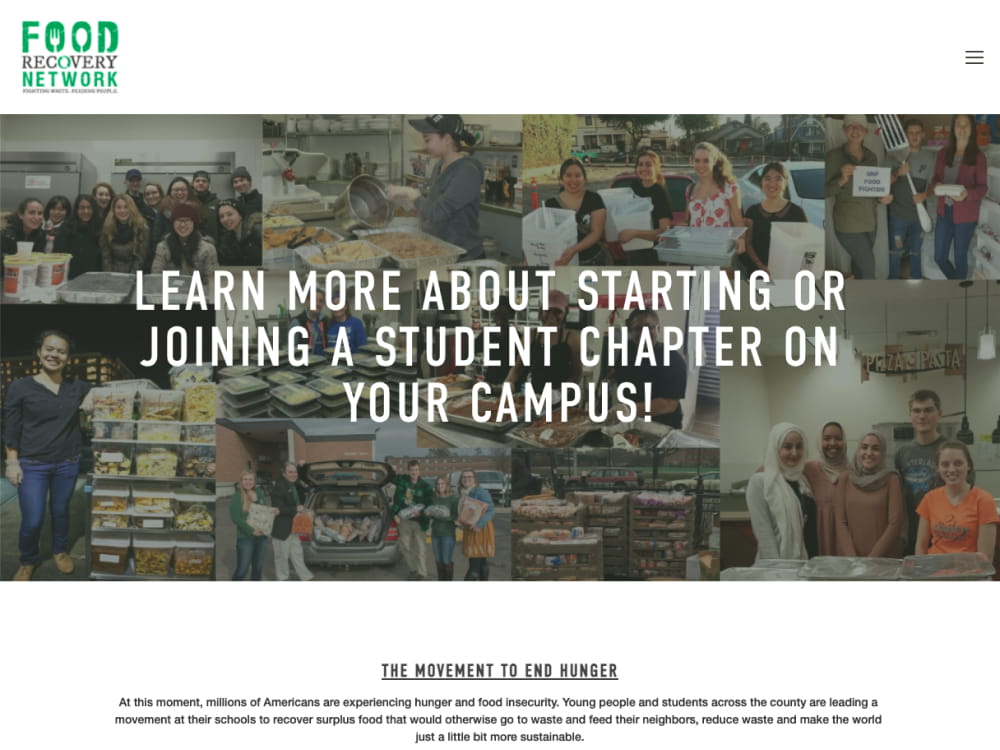Food Recovery Network is the largest student-led movement fighting food waste and working to end hunger in America. FRN partnered with Mixte to launch a two-to-three-month pilot outreach program to prospective student chapters. We strategically decided to pilot the program in Texas, due to a large and diverse audience of both higher-income and lower-income schools and demographics.
Introducing the Texas Pilot campaign
Our goal was to come up with digital strategies to introduce students to FRN and enter a pipeline of people interested in starting a student chapter. This wasn’t a fundraising campaign for FRN – it was solely an awareness campaign to inspire college students to start chapters. The goal of the pilot program was to teach us as much information on how to do that effectively.
“We needed to build awareness around Food Recovery Network to position the organization and its chapters as the solution to food waste.”
Mixte Communications
How we did it
The first month was spent strategizing on how to use digital marketing to reach college students in Texas and from there, we brought students into the pipeline to learn about FRN, show them stories of other chapters, and motivate them to eventually establish a chapter of their own at their school.
The key was to understand the touch points for these students at each point of the journey from learning about FRN to building trust and finally, getting connected with FRN. We focused on a content sprint of paid social media and Google ads, organic social media content, email newsletters and drip campaigns and blogs.
Tactics:
- Ran targeted ads in University communities – Students weren’t really on campus, which made this somewhat difficult, but we tested and iterated on ads to learn as much as we could.
- Focused on the issues of people experiencing hunger and set the context with data and research.
- Shared the stories of students who had been running chapters to nurture the audience with opportunities to connect with students.
- Reached out to lapsed chapters and schools with previous chapters.
- Set expectations with new leads – We reached out to people to build trust and connection over time before making the ask to start and run a chapter.
The Outcome
We measured the campaign’s effectiveness and provided recommendations to FRN on how to iterate on the campaign. FRN’s goal is to replicate the campaign across 10 states when students come back to school – which they’re kicking off now! While our total number of new chapter applications exceeded 20, only 9 people started chapters from our target states. Visit their website to learn more about starting or getting involved in a campus chapter.
Our Key Takeaways
-
Most students start chapters through engaging with trusted contacts. Of the 33 chapters that did join, the majority were students reactivating lapsed chapters or those recommended by word of mouth.
- Understand your audience to meet them where they are. We planned to run Facebook ads but learned that reaching college students would be more effective through Instagram and Google Search ads.
- Good visuals matter. Seeing pictures of people who were happy and in action as student chapter members proved to be effective in getting others interested to want in.
-
Digital marketing strategies alone are not sufficient to move students to start chapters. While our ads, website and email grew our email list or social media following, we learned that students require more personal touch points beyond these tactics to commit to starting a chapter on campus.
-
Future indicators of success may be messaging and partnership opportunities. We partnered with Aetna throughout the campaign to connect our messaging with student health, which elevated Aetna to a target audience we were speaking to.
There’s tremendous potential to do more of this in the future.
Want to explore how a social justice communications agency can provide digital strategy and support for your nonprofit? Send us a message to get started today or call us at 619-732-0789 x 526.






